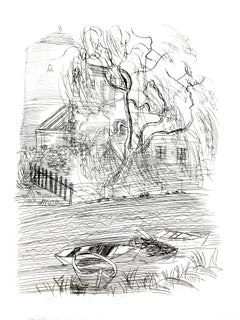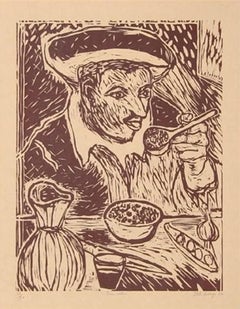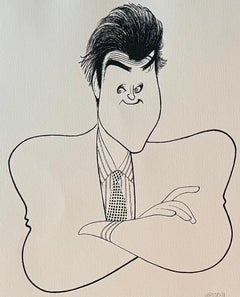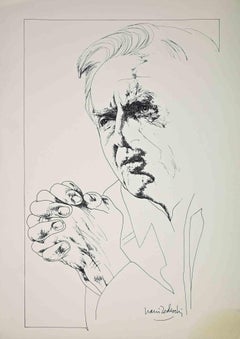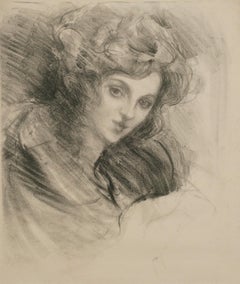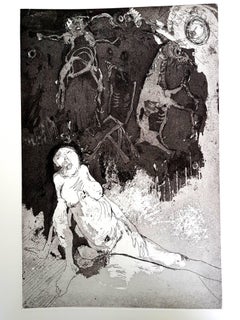Drawing Portrait Prints
to
452
1,086
304
379
78
41
Overall Width
to
Overall Height
to
744
358
136
84
66
44
41
26
19
9
3
1
136
53
48
37
31
75
361
1,275
196
14
37
98
71
78
49
133
285
122
47
62
1,476
354
54
6,544
3,595
3,111
2,642
1,907
1,544
1,229
1,154
930
789
751
443
391
386
251
210
197
194
180
169
858
722
315
80
80
171
959
820
752
Art Subject: Drawing
Raoul Dufy - French Campagne - Original Etching
By Raoul Dufy
Located in Collonge Bellerive, Geneve, CH
Raoul Dufy - French Campagne - Original Etching
Dimensions: 13 x 10".
Edition of 200
1940
Edition Les Bibliophiles du Palais, Paris
Unsigned and unumbered as issued
Category
1940s Modern Portrait Prints
Materials
Etching
The Bean Eater
By Italo Scanga
Located in New York, NY
Italo Scanga was born in the Calabria region of Italy, and at 14 immigrated to the United States with his family after World War II. Living in Detroit, he worked on the General Motor...
Category
1980s Contemporary Portrait Prints
Materials
Woodcut
$800 Sale Price
5% Off
Jay Leno NBC Tonight Talk Show Host Emmy Award Time Magazine Cover Caricature
Located in New York, NY
Jay Leno NBC Tonight Talk Show Host Emmy Award Time Magazine Cover Caricature
Al Hirschfeld (1903 – 2003)
Jay Leno
Sight Size: 19 x 16 inches
Etching with aquatint
Signed lower righ...
Category
1990s Performance Figurative Prints
Materials
Lithograph
Portrait - Lithograph by Nani Tedeschi - 1970s
Located in Roma, IT
Portrait is a screenprint on paper engraved by Nani Tedeschi (1938-2017) .
Signed on plate, on the lower right.
The state of preservation of the artwork is good.
Nani Tedeschi (...
Category
1970s Abstract Figurative Prints
Materials
Lithograph
Mlle Sablon, musical actress
Located in Fairlawn, OH
Mademoiselle Sablon, MUSCIAL ACTRESS
Lithograph, 1907
Unsigned
Provenance: estate of the artist
Reference: Belleroche No. K383
Albert Belleroche Log of lithographs, AB698
Edition: c. 10
Condition: excellent
Image size: 20 x 17 inches
Sheet size: 24 1/4 x 18 1/2 inches
Albert Gustavus de Belleroche, also known as Albert Belleroche, (22 October 1864 – 14 July 1944) was a Welsh-born painter and lithographer, who lived most of his childhood and his adulthood in Paris and England. He began as a painter, but at the turn of the century focused on lithography, for which he is most well-known. He was awarded the Chevalier de l’Ordre de Leopold by King Albert I of Belgium in 1933.
Early life
Albert de Belleroche, Lithograph of the artist's mother, Mrs. Harry Vane Milbank, circa 1900
Albert Gustavus De Belleroche was born on 22 October 1864 in Swansea. His parents were Brusseler Alice and Edward Charles, the Marquis de Belleroche, who died when he was three years old. His mother was the daughter of Desire Baruch. In March 1871, she married Harry Vane Millbank, the son of MP Frederick Milbank. He grew up in Paris and London and he used the surname Milbank until he was 30 years of age. He attained the title of count from his father's family of French Huguenot ancestry.
Career and personal life
La Danseuse (model Lili Grenier), circa 1890
In 1882, Belleroche studied briefly at Carolus-Duran's art school in Paris, preferring to study the masters like Johannes Vermeer and Sandro Botticelli at museums. He was a friend and studio-mate of John Singer Sargent in Paris and London, with the men making many sketches and paintings of each other. Some of the works that Sargent made of Belleroche are suggestive of an emotional relationship between the men and Belleroche may have been the love of Sargent's life. Dorothy Moss, an art historian, states "Sargent's portraits of Belleroche, in their sensuality and intensity of emotion, push the boundaries of what was considered appropriate interaction between men at this period." Belleroche was financially independent and did not need or desire to obtain work through commissions. Instead, he chose who he would paint, which included Japanese wrestler...
Category
Early 1900s Impressionist Portrait Prints
Materials
Lithograph
Jean Jansem - Original Etching
By Jean Jansem
Located in Collonge Bellerive, Geneve, CH
Jean Jansem - Original Etching
Title: Loneliness
Dimensions: 40 x 30 cm
Edition of 175
Paper: vélin de Rives
1974
Unsigned and unumbered as issued
Category
1970s Modern Figurative Prints
Materials
Etching
Bob Hope Hollywood Legend 20th Century Oscars Academy Awards Litho Movie Star
Located in New York, NY
Bob Hope Hollywood Legend 20th Century Oscars Academy Awards Litho Movie Star
Al Hirschfeld (1903-2003)
Bob Hope
Signed lower right, Numbered 16/200 lower left
15 x 11 3/4 inches (...
Category
1970s Performance Figurative Prints
Materials
Lithograph
St Paul holding a Sword in His...-Etching by Marcantonio Raimondi-16th Century
Located in Roma, IT
Etching on paper realized by Marcantonio Raimondi after Raphael.
Ref. Cat. Raisonné Oberhuber n. 76.
Good condition.
Category
1870s Modern Figurative Prints
Materials
Etching
Portrait No. 1, by Francois Houtin
Located in Palm Springs, CA
In Portrait #1, François Houtin transforms botanical motifs into an elaborate fantasy of form and texture. Using fine, rhythmic lines, he constructs an imaginary figure that feels pa...
Category
1970s Contemporary Portrait Prints
Materials
Etching
Leonor Fini, rare lithograph on Arches paper, circa 1980
By Leonor Fini
Located in Saint Ouen, FR
Rare print handsigned by surrealist artist Leonor Fini, inscreasingly esteemed with the movement of rediscovering art by women. This rare original lithograph is an artist proof in ve...
Category
Mid-20th Century Surrealist Figurative Prints
Materials
Paper
Sarah Wearing Her Bonnet, Impressionist Collotype after Mary Cassatt
By Mary Cassatt
Located in Long Island City, NY
Mary Cassatt, After, American (1844 - 1926) - Sarah Wearing Her Bonnet, Portfolio: Twenty Four Masterpieces of Graphic Art, Year: Year Printed 1974, Medium: Collotype, Image Size:...
Category
1970s Impressionist Portrait Prints
Materials
Photogravure
Julia Asleep - Portrait British Art Julia
Located in London, GB
This original etching in colour hand signed in pencil by the artist “Auerbach” at the lower right margin. It is dated ‘01’ [2001] next to the signature.
It is inscribed ‘HC’ and numb...
Category
Early 2000s Portrait Prints
Materials
Etching
FAST DUDE (BASKETBALL)
Located in Aventura, FL
Offset lithograph in colors on paper. Hand signed and numbered by the artist. From the edition of 500.
Artwork is in excellent condition. Certificate of authenticity included. Al...
Category
Late 20th Century Contemporary Figurative Prints
Materials
Paper, Lithograph
$100 Sale Price
50% Off
R. Layni, Zeichnungen folio, "One-Year-Volunteer Private" Collotype plate V
Located in Palm Beach, FL
Egon Schiele (1890 – 1918), AUSTRIA
“ART CANNOT BE MODERN, ART IS PRIMORDIALLY ETERNAL.” -SCHIELE
Defiantly iconoclastic in life and art, Egon Schiele is esteemed for his masterful...
Category
1910s Vienna Secession Portrait Prints
Materials
Paper
La Voix Tintante, from Poesies Antillaises
Located in Washington, DC
Artist: Henri Matisse
Title: La Voix Tintante
Portfolio: Poesies Antillaises
Medium: Lithograph
Year: 1972
Edition: 250
Sheet Size: 14 7/8" x 11 1/8"
Image Siz...
Category
1970s Post-Modern Portrait Prints
Materials
Lithograph
Carmen, The Man Behind the Mask - Original Etching (Cramer #52)
Located in Paris, IDF
Pablo PICASSO
Carmen, The Man Behind the Mask, 1949
Original burin engraving (Atelier Lacourière, Paris)
Unsigned
On Montval wove paper 33 x 26 cm (12.9 x 10.2 in)
REFERENCES :
- ...
Category
1940s Modern Portrait Prints
Materials
Etching
SAINT APOLLONIA FS II.333
By Andy Warhol
Located in Aventura, FL
Screen print in colors on Essex Offset Kid Finish paper. Hand signed and numbered by Andy Warhol. Published by Dr. Frank Braun, Düsseldorf. Hand numbered AP 21/35. From the Artist Proof edition (outside the main edition of 250). Frame size approx 31 x 23 inches.
The artwork is in excellent condition. Gallery Art issued COA included. All reasonable offers will be considered.
Andy Warhol’s Saint Apollonia...
Category
1980s Pop Art Figurative Prints
Materials
Paper, Screen
Jean Cocteau - Juliet Waiting for Romeo - Original Lithograph
By Jean Cocteau
Located in Collonge Bellerive, Geneve, CH
Original Lithograph by Jean Cocteau
From "Théâtre" Portfolio, 1957
Edition: 207 / 8800
Dimensions: 22.5 x 15.5 cm
Jean Cocteau
Writer, artist and film director Jean Cocteau was on...
Category
1950s Modern Portrait Prints
Materials
Lithograph
Leonor Fini, rare lithograph on Arches paper, circa 1980
By Leonor Fini
Located in Saint Ouen, FR
Rare print handsigned by surrealist artist Leonor Fini, inscreasingly esteemed with the movement of rediscovering art by women. This rare original lithograph is an artist proof in ve...
Category
Mid-20th Century Surrealist Figurative Prints
Materials
Paper
Hommage to Jan Vermeer - Lithograph by Renato Guttuso - 1980s
Located in Roma, IT
Hommage to Jan Vermeer is a lithograph realized by Renato Guttuso in 1980.
Hand-signed on the lower.
Numbered, edition of 100.
Drystamp "La Spirale".
Category
1980s Contemporary Figurative Prints
Materials
Lithograph
$498 Sale Price
30% Off
Leonor Fini, King, rare lithograph on Arches paper, circa 1980
By Leonor Fini
Located in Saint Ouen, FR
Rare print handsigned by surrealist artist Leonor Fini, inscreasingly esteemed with the movement of rediscovering art by women. This rare original lithograph is an artist proof in ve...
Category
Mid-20th Century Surrealist Figurative Prints
Materials
Paper
Raoul Dufy - Adam and Eve in Modernity - Original Etching
By Raoul Dufy
Located in Collonge Bellerive, Geneve, CH
Raoul Dufy - Haussmann Architecture - Original Etching
Dimensions: 13 x 10".
Edition of 200
1940
Edition Les Bibliophiles du Palais, Paris
Raoul Dufy
Born in 1877, the French painte...
Category
1940s Modern Portrait Prints
Materials
Etching
Still Life - Lithograph
Located in Collonge Bellerive, Geneve, CH
(after) Raoul Dufy
Lithograph after a watercolor, published in the book "Lettre à mon peintre Raoul Dufy." Paris, Librairie Académique Perrin, 1965.
Printed signature
Di...
Category
1940s Fauvist Animal Prints
Materials
Lithograph
JEAN COCTEAU FS II.329A
By Andy Warhol
Located in Aventura, FL
Hand signed and numbered by the artist. From the edition of 250. Screenprint in colors on paper. Commissioned to commemorate the opening of The Severin Wunderman Foundation in Ir...
Category
1980s Pop Art Figurative Prints
Materials
Paper, Screen
Portrait After Raphael - Original Etching by Thomas Holloway - 1810
Located in Roma, IT
Portrait After Raphael is an original artwork realized by Thomas Holloway (1748 - 1827).
Original Etching from J.C. Lavater's "Essays on Physiognomy, Designed to promote the Knowled...
Category
1810s Old Masters Portrait Prints
Materials
Etching
Portrait of a Child - Woodcut by Mino Maccari - Mid 20th Century
By Mino Maccari
Located in Roma, IT
Portrait of a Child is an original Woodcut Print realized by Mino Maccari in mid-20th century.
Good condition on a yellowed paper, included a white cardboard passpartout (35x28 cm)....
Category
Mid-20th Century Modern Figurative Prints
Materials
Woodcut
The Affection - Original Lithograph by Paul Gavarni - 1881
By Paul Gavarni
Located in Roma, IT
The affection is an original lithograph artwork on ivory-colored paper, realized by the French draftsman Paul Gavarni (after) (alias Guillaume Sulpice Chevalier Gavarni, 1804-1866) i...
Category
1880s Modern Figurative Prints
Materials
Paper, Lithograph
The Conversation - Original Lithograph by Paul Gavarni - 1881
By Paul Gavarni
Located in Roma, IT
The conversation is an original lithograph artwork on ivory-colored paper, realized by the French draftsman Paul Gavarni (after) (alias Guillaume Sulpice Chevalier Gavarni, 1804-1866...
Category
1880s Modern Figurative Prints
Materials
Paper, Lithograph
$166 Sale Price
30% Off
The Gentle Request - Original Lithograph after Paul Gavarni - 1881
By Paul Gavarni
Located in Roma, IT
The Gentle Request is an original lithograph artwork on ivory-colored paper, realized by the French draftsman Paul Gavarni (after) (alias Guillaume Sulpice Chevalier Gavarni, 1804-18...
Category
1880s Modern Figurative Prints
Materials
Paper, Lithograph
$166 Sale Price
30% Off
Reactions to Death - Original Etching by Thomas Holloway - 1810
Located in Roma, IT
Reactions to Death is an original artwork realized by Thomas Holloway for Johann Caspar Lavater's "Essays on Physiognomy, Designed to promote the Knowledge and the Love of Mankind",...
Category
1810s Modern Figurative Prints
Materials
Etching
Silhouette - Original Etching by Thomas Holloway - 1810
Located in Roma, IT
Silhouette is an original artwork realized by Thomas Holloway for Johann Caspar Lavater's "Essays on Physiognomy, Designed to promote the Knowledge and the Love of Mankind", London,...
Category
1810s Modern Figurative Prints
Materials
Etching
Painting in Gold Frame
Located in Aventura, FL
From the Paintings series. Woodcut, Lithograph, screen print and collage on Arches 88 paper. Hand signed, dated and numbered by Roy Lichtenst...
Category
1980s Pop Art Portrait Prints
Materials
Lithograph, Screen, Woodcut, Paper
IMAGE - The Gloves - Original Lithograph after F. Léger - 20th Century
Located in Roma, IT
The gloves is an original lithograph on paper realized by Fernand Léger (1881-1955).
Very good conditions except for some little foxings.
Sheet dimension: 21.5 x 30.5
The artwork ...
Category
20th Century Cubist Figurative Prints
Materials
Lithograph
Greta Garbo Swedish American Movie Film Star Goddess Hollywood Mid 20th Century
Located in New York, NY
Greta Garbo Swedish American Movie Film Star Goddess Hollywood Mid 20th Century
Al Hirschfeld (1903-2003)
Greta Garbo
Plate Size: 13 7/8 x 9 3/4
Paper Size:...
Category
1980s American Realist Figurative Prints
Materials
Lithograph
Madame Pompadour
Located in New York, NY
The simple elegance of this original lithograph, created by Henri Matisse in 1955, is undeniably beautiful. From the edition of 2850, the print measures 12 ½ x 10 in. (31.5 x 25 cm...
Category
20th Century Portrait Prints
Materials
Lithograph
Leonor Fini, rare lithograph on Arches paper, circa 1980
By Leonor Fini
Located in Saint Ouen, FR
Rare print handsigned by surrealist artist Leonor Fini, inscreasingly esteemed with the movement of rediscovering art by women. This rare original lithograph is an artist proof in ve...
Category
Mid-20th Century Surrealist Figurative Prints
Materials
Paper
Marc Chagall - The Bible - Hagar in the Desert - Original Lithograph
By Marc Chagall
Located in Collonge Bellerive, Geneve, CH
Marc Chagall, Original Lithograh depicting an instant of the Bible.
Technique: Original lithograph in colours (Mourlot no. 234)
On the reverse: another black and white original litho...
Category
1960s Modern Figurative Prints
Materials
Lithograph
NINA DE ROSA
Located in Aventura, FL
Hand signed, dated and numbered by the artist. Artwork is in excellent condition. Certificate of Authenticity included. All reasonable offers will be considered.
Category
1980s Contemporary Figurative Prints
Materials
Lithograph, Paper
$1,125 Sale Price
25% Off
Jean Cocteau - Marine Mountains - Original Lithograph
By Jean Cocteau
Located in Collonge Bellerive, Geneve, CH
Jean Cocteau - Marine Mountains - Original Lithograph
Dimensions: 38 x 28 cm
Edition: 200
In Rives
From: COCTEAU. — VERDET (André). Montagnes marines. S. l. (Paris), Les Messagers du...
Category
1960s Modern Portrait Prints
Materials
Lithograph
Pablo Picasso - Le Vieux Roi (The Old King), original lithograph
Located in London, GB
Pablo Picasso
Le Vieux Roi (The Old King) Seigneur et deux filles, 1959
Original Lithograph on Arches light paper with Mourlot watermark,
signed in the stone with a red signature.
p...
Category
1950s Modern Figurative Prints
Materials
Lithograph
$2,177 Sale Price
20% Off
The Hypochondriac - Original Lithograph and Offset by George Grosz - 1923
By George Grosz
Located in Roma, IT
The Hypochondriac is an original offset and lithograph print realized by George Grosz.
The artwork is the plate n.21 from the portfolio Ecce Homo published between 1922/1923, editio...
Category
1920s Expressionist Portrait Prints
Materials
Lithograph, Offset
Thorny branch
Located in Middletown, NY
Milan: c1970.
Lithograph on white wove paper, 20 x 24 1/4 inches (508 x 615 mm), the full sheet. Signed and titled (illegible) in pencil in the lower margin. In good condition with ...
Category
Mid-20th Century Modern Figurative Prints
Materials
Lithograph
Composizione
Located in Middletown, NY
Milan: 1969.
Linocut on watermarked CM Fabriano deluxe paper, 23 1/2 x 19 3/4 inches (596 x 501 mm), the full sheet. Signed, numbered 2/10, dated, and extensively inscribed in penci...
Category
Mid-20th Century Modern Figurative Prints
Materials
Linocut
Pearls and Emeralds
By Erté
Located in Washington, DC
Artist: Erté
Title: Pearls and Emeralds
Medium: Embossed serigraph
Year: 1990
Edition: 265/300
Sheet Size: 41 3/4" x 29 1/4"
Image Size: 35 1/4" x 23 1/4"
Signature: Stamped signature
Category
1990s Surrealist Figurative Prints
Materials
Screen
THE KING
By Keith Haring
Located in Aventura, FL
Lithograph in colors on wove paper. Hand signed, dated and numbered by Keith Haring. Published by Nicole Fauché, Paris. Littmann 115. Edition 4/50.
Artwork is in excellent conditio...
Category
1980s Pop Art Figurative Prints
Materials
Screen, Paper
$55,950
Giclée Print: 'PURPLE RAIN'
Located in New York, NY
GRAPHICTHERAPY is David Calderley:
an Englishman in New York, Creative/Art Director, Graphic Designer and Illustrator. After graduating from the esteemed St. Martin’s School of Art ...
Category
2010s Contemporary Figurative Prints
Materials
Archival Paper, Giclée
Salvador Dali - The Laurels of Happiness - Original Signed Engraving
Located in Collonge Bellerive, Geneve, CH
Salvador Dali - The Laurels of Happiness - Original Signed Engraving
Handsigned in pencil and Numbered
Edition: F195/195
- Printer: Atelier Rigal.
- Paper: Rives vellum ; each etchi...
Category
1970s Surrealist Figurative Prints
Materials
Etching
Giacometti 'Nu Aux Fleurs' (Nude With Flowers) Limited Edition, Signed Print
Located in San Rafael, CA
Alberto Giacometti (1901-1966)
Nu Aux Fleurs (Nude with Flowers), 1960
Lithograph on B.F.K. Rives paper (water marked)
Signed in pencil by the artist lower right
Editioned in penci...
Category
1960s Figurative Prints
Materials
Lithograph
Portrait - Etching by Mariette Lydis - Mid-20th Century
Located in Roma, IT
Lithograph on paper realized by Mariette Lydis in the middle-20th Century.
Monogrammed in the plate.
Good condition.
Category
Mid-20th Century Modern Figurative Prints
Materials
Etching
SAINT APOLLONIA FS II.332
By Andy Warhol
Located in Aventura, FL
Hand signed and numbered on front by the artist. Screenprint on Essex Offset Kid Finish paper. Published by Dr. Frank Braun, Düsseldorf, Germany. From the edition of 250. Framed si...
Category
1980s Pop Art Figurative Prints
Materials
Paper, Screen
DINE IN BLACK GREASE
By Jim Dine
Located in Portland, ME
Dine, Jim (American, b. 1935) DINE IN BLACK GREASE. Lithograph on wove paper, 2000. Self-Portrait. Published by Tamarind Institue and printed by Billl Lagattuta. Signed, dated, and n...
Category
Early 2000s Portrait Prints
Materials
Lithograph
Figure in Skirt Claes Oldenburg playful erotic nude etching in rainbow of color
Located in New York, NY
A woman in slip-on heels leans languidly on a cloud-like phallus defined with loose, sketched lines. Gazing dreamily past the viewer, the topless woman dons a diaphanous tutu, and at...
Category
1970s Pop Art Figurative Prints
Materials
Etching, Aquatint
Wolfman
By Donald Saff
Located in Middletown, NY
Etching with aquatint on white wove paper with a deckle edge, 23 1/2 x 17 1/2 inches (598 x 317 mm); sheet 30 x 22 1/2 inches (762 x 571 mm), full margins. Signed and numbered 4/10 i...
Category
Late 20th Century American Modern Animal Prints
Materials
Handmade Paper, Etching, Aquatint
Stephen Sondheim Tony Awards Broadway Musical Theatre NYT Published
Located in New York, NY
Stephen Sondheim Tony Awards Broadway Musical Theatre NYT Published
Al Hirschfeld (1903-2003)
Stephen Sondheim
Lithograph on paper
Sight 21 x 15 inches
Signed lower right, numbere...
Category
1980s Performance Figurative Prints
Materials
Lithograph, Paper
"La Cage Aux Folles" Broadway Musical Tony Award LGBT NY Times Published
Located in New York, NY
"La Cage Aux Folles" Broadway Musical Tony Award LGBT NY Times Published
Al Hirschfeld (1903-2003)
"La Cage Aux Folles"
Lithograph on heavy paper
Sight size 16 x 18 3/4 inches
Signe...
Category
1990s Performance Figurative Prints
Materials
Paper, Etching, Lithograph
Raoul Dufy - Champs Français - Original Etching
By Raoul Dufy
Located in Collonge Bellerive, Geneve, CH
Raoul Dufy - Champs Français - Original Etching
Dimensions: 13 x 10".
Edition of 200
1940
Edition Les Bibliophiles du Palais, Paris
Unsigned and unumbered as issued
Category
1940s Modern Portrait Prints
Materials
Etching
Pasiphae Frontispiece
Located in Washington, DC
Artist: Henri Matisse
Title: Pasiphae Frontispiece
Portfolio: Pasiphae
Medium: Linocut on Arches vellum
Date: 1944
Edition: 200
Frame Size: 19 3/4" x 17 1/4"
Sheet Size: 13 3/4" x 10...
Category
20th Century Modern Portrait Prints
Materials
Linocut
Man Ray-Elizabeth Vintage
By Man Ray
Located in Brooklyn, NY
Man Ray's Elizabeth is framed in a sleek black metal frame with a 3/8-inch front profile and a 7/8-inch side profile. The overall dimensions are approximately 12.25 x 10.25 x 7/8 inc...
Category
1970s Surrealist Portrait Prints
Materials
Offset
CHEVALIER EN ARMURE, PAGE ET FEMME NUE
Located in Aventura, FL
Selected from the personal collection inherited by Marina Picasso, Pablo Picasso's granddaughter. After Pablo Picasso's death, his granddaughter Marina authorized the printing of t...
Category
1980s Cubist Portrait Prints
Materials
Paper, Lithograph
$1,450 Sale Price
50% Off
Fourteenth Street Oriental
Located in Middletown, NY
New York: Associated American Artists, 1950. Drypoint and aquatint on white wove paper, 5 7/8 x 3 15/16 inches (150 x 100 mm), full margins. Signed in pencil in the lower margin. Pri...
Category
Mid-20th Century American Realist Portrait Prints
Materials
Drypoint, Aquatint
